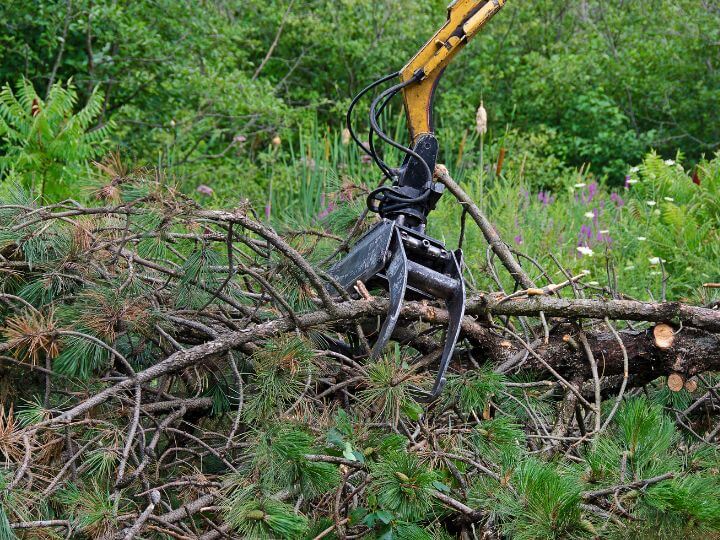In this article, we delve into the potential hazards linked to DIY storm-damaged tree removal and argue the business case for entrusting this task to professional arborists, like those at Extreme Tree Service. We outline the skills, practical knowledge, and tools these specialists bring to ensure a thorough, safe, and efficient removal process. Additionally, we detail how professionals evaluate the status of storm-damaged trees and decide on the most suitable remedy. Touching on the financial and temporal efficiency of professional engagement, we dissect the cost-benefit ratios, potential savings, as well as insurance aspects and the risk of fines due to regulatory non-compliance. In this vein, we explore the long-term benefits of professional tree removal, from promoting the health of other trees and the surroundings to preventing potential damage, enhancing safety, and boosting property aesthetic appeal and value.
The Dangers of DIY Tree Removal After Storm Damage
DIY attempts at tree removal could potentially expose individuals to serious injuries, especially when dealing with storm-damaged trees. Storm-damaged trees are fundamentally unstable, posing significant danger during removal. The tensions in the wood are abnormal and unpredictable, thus bark can pop off or the tree can snap unpromptedly, causing grave injuries. Undoubtedly, understanding the risks associated with DIY tree removal is key to avoiding severe mishaps and hazards.
Understanding the Severity and Complexity of Storm-Damaged Trees
Storm-damaged trees are not like other trees. They’re often damaged in complex ways that could make their removal incredibly hazardous without the right expertise. A tree may be leaning precariously, branches may be caught in power lines, the roots may be exposed or damaged, or the tree could be split down the middle. Deciphering the safest, most efficient way to take down such a tree requires experience and specialized knowledge that the average homeowner just doesn’t possess.
Potential Risks of DIY Tree Removal
There is a myriad of dangers associated with DIY tree removal. Falling branches can cause physical injuries, some of which can be fatal. Not to mention that incorrectly used tools and equipment pose another risk like chainsaw accidents. Furthermore, if the tree, or parts of it, fall into a neighbor’s yard, you might be liable for the damage.
The Importance of Safety Precautions
Taking proper safety precautions is vital when dealing with storm-damaged trees. Wearing the correct protective gear, like hard hats, safety glasses, and chainsaw-protective pants, is a must but, alone, not enough. More importantly, knowing how to properly use the necessary equipment and having the ability to accurately estimate the situation is key. Recognizing how the tensions in the tree could cause it to fall is crucial to preventing harm.
The Role of Professional Arborists in Storm-Damaged Tree Removal
It’s important to underscore the pivotal role professional arborists play in managing storm-damaged trees. These professionals offer invaluable services, which consist of evaluating the damage, planning and executing the safe removal of the trees, and afterwards, an efficient clean-up.
Skills and Experience of Professional Arborists
Certified arborists hold a wealth of knowledge about trees and have specialised training to provide these services effectively. Their skills and experience allow them to work with storm-damaged trees and ensure the right removal techniques are used to minimising risks involved.
Proper Tools and Equipment Used By Professionals
Arborists also have access to the right tools and equipment necessary for safe and efficient tree removal, many of which an average homeowner likely does not own.
Understanding of Local Regulations and Permits
Importantly, arborists understand local regulations and permit requirements related to tree removal, ensuring the process is conducted legally. Violating these regulations can result in fines or other penalties.
Assessment Process: How Professionals Evaluate Storm-Damaged Trees
An integral part of professional tree removal service is the assessment process. This process involves identifying the extent of tree damage, evaluating risks to surrounding structures, and determining the best course of action for removal.
Identifying the Extent of Tree Damage
Arborists are trained to identify the extent of damage to a tree. This involves checking for signs of disease, evaluating the stability of the tree, and identifying any potential risks that may be present.
Evaluating the Risk to Surrounding Structures
Apart from assessing the tree itself, arborists will evaluate risks to surrounding structures. This might include the danger to nearby homes, buildings, fences, or power lines.
Determining the Best Course of Action for Removal
Once these assessments have been made, the arborist will determine the best course of action for removing the tree. This could include cutting it down in sections, using heavy machinery to support the tree during removal, or choosing the optimum direction for the tree to fall.
Execution Process: How Professionals Carry Out Tree Removal
Professional arborists follow a structured process when removing storm-damaged trees. From initial preparations, right down to final clean up, they ensure that every stage of the process is carried out safely and efficiently.
Preparation and Safety Measures Taken By Professionals
Arborists first set up a significant safe zone around the tree. They use ropes and harnesses to physically manage the tree, and take necessary precautions to defend nearby structures.
The Tree Removal Process Explained
Professionals approach the tree from the top down, cutting off branches as they descend. This is safer than endeavoring to cut the tree from the bottom. Furthermore, professionals never turn their back on the tree being worked on—as falling sections of the tree can cause injury.
Debris Removal and Site Clean-up
After the tree is securely dismantled, the arborists assure a thorough clean-up of the site. They remove all the debris, making sure the area is clear and safe once more.
Cost and Time Efficiency of Professional Assistance
While hiring professionals may initially seem expensive, the efficiency, safety, and peace of mind they offer, in the long run, are sure to outweigh the costs.
Comparison of Time and Effort Between DIY and Professional Removal
DIY tree removal may initially seem cost-effective, but when you consider the time and effort factor, the scales tilts in favor of professional assistance. The job is almost always faster when done by professionals, freeing up valuable time for homeowners.
Cost Benefit Analysis of Hiring Professionals
Hiring professionals could be a smart financial decision. This because any mishaps during DIY efforts, not only risks your health, but could damage your property or that of your neighbor, leading to costly repairs.
Potential Financial Risks of DIY Tree Removal
The potential financial risks of DIY tree removal are enormous. Damage caused to property, injuries incurred, and the cost of necessary tools and equipment, all contribute in driving up the actual cost of DIY tree removal.
Insurance Considerations During Tree Removal
Insurance considerations during tree removal are also important. Most homeowner insurance policies might not cover incidents during DIY tree removal. On the other hand, professional tree service companies often have their own insurance policies.
The Long-Term Benefits of Professional Tree Removal
There are several long-term benefits of hiring professionals for storm-damaged tree removal, such as promoting the health of other trees and landscape, preventing future damage and enhancing property aesthetics.
Promoting the Health of Other Trees and Landscape
Removing the damaged tree in a controlled manner can greatly benefit the rest of your landscape in terms of sunlight exposure and the removal of disease or pest threats.
Preventing Future Damage and Promoting Safety
Proper tree removal can also prevent future damage. Remaining stumps or shallow roots of old trees can pose tripping hazards or serve as hotbeds for pests and diseases.
Improving Property Aesthetic and Value
With the damaged tree removed and the rest of your property secured, you boost not only your landscape’s visual appeal but also possibly your property’s overall value.
1. Why is it important to hire professionals for storm-damaged tree removal?
Professional arborists understand the complexities and potential risks associated with storm-damaged tree removal. Their specialized training and equipment allow for a safe, efficient process that minimizes the possibility of further damage or injury.
2. What risks can professional tree removal services help to mitigate?
Professionals help to minimize personal injury risks, property damage risks, and potential legal issues arising from improper tree removal. Simultaneously, they also consider ecological considerations that could be overlooked by non-professionals.
3. How does professional arborist certification influence storm-damaged tree removal?
Certified arborists adhere to the highest safety standards and professional practices, ensuring consistent, reliable, and safe tree removal services. Certification also guarantees a specialised knowledge of tree biology, which aids in efficient tree removal and post-storm recovery.
4. How does professional tree removal align with insurance requirements?
Professional tree removal services often comply with the stipulations of property insurance policies. Using professional services ensures that procedures meet safety regulations, which can facilitate smooth insurance claims for any storm-related damages.
5. What is the role of professionals in evaluating the damage caused by storms to trees?
Professionals can accurately assess the extent of damage, determine the danger posed by the tree, and recommend the best course of action. This specialist knowledge enables them to make informed decisions that protect people, property, and the environment.
6. Why is it crucial to seek professional help immediately after a storm?
Seeking immediate professional help ensures early threat mitigation, preventing further damages. Professionals can quickly identify unstable trees and take necessary action, thus providing peace of mind in stressful post-storm situations.



0 Comments